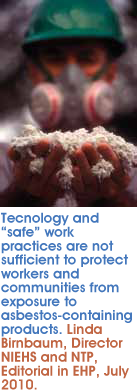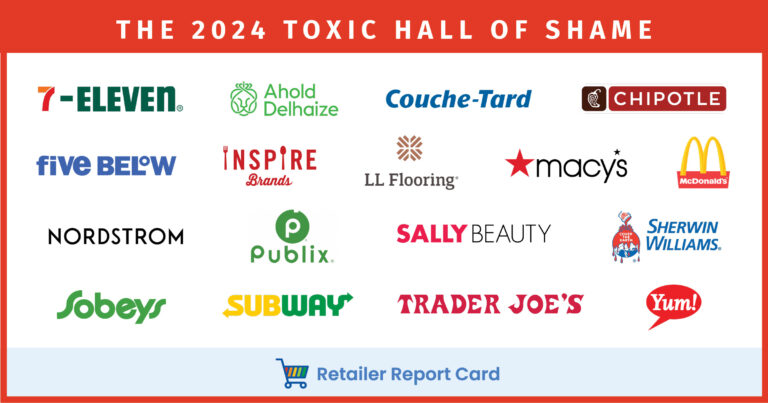Asbestos
Want more? Sign up for our free updates!
What is asbestos?
Asbestos is a notoriously toxic substance. A known carcinogen, it can cause fatal illnesses including mesothelioma, asbestosis, and cancers of the lung, larynx, and ovaries. It is estimated that each year more than 40,000 Americans die from entirely preventable asbestos-caused diseases. In fact, a recent analysis concluded that up to 15,000 Americans die every year from asbestos-related diseases.
Why should I be concerned?
Today, while asbestos is banned in nearly 70 countries, it is not banned in the United States. There is still much more work to be done to truly protect us from this dangerous substance. All asbestos should be banned, not just individual fibers.
When the Toxic Substances Control Act (TSCA) was enacted in 1976, it was intended to ensure that chemicals are safe throughout their lifecycle, from manufacture to use and disposal. But weaknesses in the law left the Environmental Protection Agency (EPA) unable to act on known health dangers.
Other laws, such as those setting air, water, and workplace safety standards, do not adequately regulate exposure to most chemicals, nor do they address the hazards a chemical may pose over its entire lifecycle. Asbestos is still used in some building and automotive materials as well as the manufacturing process for chlor-alkali plants. Asbestos fibers can be released into the air during demolition of buildings constructed with asbestos products, along highways from disintegration of brake pads, and near facilities where asbestos products are manufactured.
A decade of scientific research and more than 100,000 pages of records to support regulation were not enough
In 1989, the EPA issued a rule under TSCA that banned most uses of asbestos. The ban followed 10 years of research and was based on more than 100,000 pages of administrative record supporting the EPA’s attempt to regulate most uses of asbestos, including brake linings, roofing, pipes, tile, and insulation. Two years later, the EPA’s regulation was overturned by the Fifth Circuit Court of Appeals. Despite the court’s acknowledgment that “asbestos is a potential carcinogen at all levels of exposure,” it ruled that the agency’s administrative record failed to demonstrate that the regulation was the “least burdensome alternative,” as required under the law at that time. After the court’s ruling, the EPA’s burden to regulate the use of most toxic substances under TSCA was insurmountable until Congress updated the law in 2016.
There is a long list of asbestos-containing products that have never been banned
The court upheld the EPA’s efforts to ban any historical uses of asbestos that were not currently in use and to ban any future new uses of asbestos. However, the court rejected the EPA’s efforts to ban existing uses of asbestos including: asbestos-cement, corrugated and flat sheet, asbestos clothing, pipeline wrap, roofing felt, vinyl-asbestos floor tile, asbestos-cement shingle, millboard, asbestos-cement pipe, automatic transmission components, clutch facings, friction materials, disc brake pads, drum brake linings, brake blocks, gaskets, valve and pump packings, non-roofing coatings, and roof coatings. These ongoing uses of asbestos pose a serious danger to human health.
Though Congress updated the Toxic Substances Control Act in 2016, giving EPA more power to regulate asbestos and other chemicals, so far the agency has not used it.
Products where asbestos is found
Asbestos continues to be used in numerous applications including: (1) building supplies such as asbestos-cement shingle, asphalt roofing shingles and coatings, pipeline wrap, vinyl-asbestos floor tile, millboard, asbestos cement pipe, and asbestos clothing; and (2) automotive products such as automatic transmission components, clutch facings, friction materials, disc brake pads, drum brake linings, brake blocks, gaskets, and valve and pump packing. Except for the roofing materials, the other products listed are imported but no longer made in the United States. In addition to intentional use in building and automotive products, asbestos is known to contaminate other minerals that are used in consumer products including vermiculite, talc, and taconite. In some parts of the United States, stone, sand, and gravel used as surfacing for schoolyards, home sites, and roadbed are contaminated with asbestos.
Exposure and health risks
Asbestos consists of six different fibrous minerals, all of which are hazardous and can cause cancer. Asbestos minerals are also found as contaminants in other minerals and can cause disease in workers who extract these materials or use them in various industries. Consumer products made from these materials also pose dangers to everyone in contact with them. Most people are exposed to asbestos by breathing contaminated air. If asbestos-containing materials such as insulation, flooring, and ceiling tiles become old and flake, then the asbestos fibers can become airborne and breathable. Indoor air measurements within homes, schools, and other buildings may range between 30 to 6,000 fibers per cubic meter depending on what materials were used during construction. Exposed workers can bring home asbestos in dust on their clothing or shoes, contaminating their households and putting their families at risk for asbestos disease. Exposure to asbestos also can occur through drinking contaminated water.
Inhaling asbestos can lead to chronic lung disease and is known to cause at least four types of cancer: lung, mesothelioma (a cancer of the thin membranes that surround the lungs and intestinal organs), laryngeal, and ovarian. Cigarette smoking interacts synergistically with asbestos to dramatically increase lung cancer risk. Other cancers that have been linked to asbestos exposure include colorectal, throat, esophageal, and kidney, as well as cancers of the gallbladder. One of the chronic non-cancer diseases caused by asbestos is a scarring of the lungs, called asbestosis, which causes difficulty in breathing, impaired lung function, heart enlargement, disability and death.
How asbestos is designated and regulated now
- The International Agency for Research on Cancer (IARC) recognizes asbestos as a known human carcinogen. The World Health Organization (WHO) has called for bans on new uses of asbestos products globally. More than 52 countries across the world have now banned asbestos, most recently South Africa and Korea.
- The National Institute of Health’s (NIH) National Toxicology Program recognizes asbestos as a known human carcinogen.
- The U.S. Surgeon General has stated there is no known safe level of exposure to all forms of asbestos.
- The EPA recognizes asbestos as a known human carcinogen and established regulations to reduce or eliminate exposures of asbestos in schools, emissions from industries, and from building demolition.
- The Consumer Product Safety Commission (CPSC) banned asbestos in certain products, such as textured paint and wall patching compounds.
- Asbestos is listed on California’s Prop 65 list of chemicals known to cause cancer.
Our Priorities
Take Action

